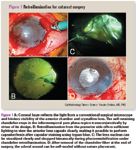Article
Chandelier endoillumination enhances surgical safety
The use of 25-gauge transconjunctival chandelier endoillumination during cataract surgery in patients with severely opacified corneas is proving to be a boon for surgeons and patients alike. The technique facilitates clear intraocular visualization, and because the chandelier does not have to be held in place, the surgeon can perform capsulorrhexis and subsequent manipulations bimanually as usual.

Key Points
Chicago-The use of 25-gauge transconjunctival chandelier endoillumination during cataract surgery in patients with severely opacified corneas is proving to be a boon for surgeons and patients alike.
The technique facilitates wide-angle, clear intraocular visualization through the hazy cornea. Because the chandelier (Synergetics Inc.) does not have to be held in place, the surgeon can perform capsulorrhexis and bimanual manipulations intraocularly with ease. Yusuke Oshima, MD, PhD, reported his experience with the procedure at the American Society of Cataract and Refractive Surgery (ASCRS) annual meeting.
Cataract surgery and IOL implantation can become complicated procedures in the presence of corneal haze, a small pupil, and a shallow anterior chamber, making adequate visualization of the crystalline lens and anterior capsule very difficult, therefore the rationale for this procedure, according to Dr. Oshima, associate professor, department of ophthalmology, Osaka University Medical School, Osaka, Japan.
"Cataract surgery under conventional microscopic illumination is challenging in eyes with corneal opacities because of poor visibility of the lens and anterior capsule," Dr. Oshima said. "To enhance visibility, anterior capsule staining with indocyanine green or trypan blue may be helpful for the capsulorrhexis, but is insufficient for completing the subsequent surgical procedures."
Additionally, the use of a light pipe-which provides spotlight illumination-can be inadequate in eyes with bullous keratopathy. The light pipe also requires that the instrument is held in place manually.
Surgical procedure

"Because the chandelier light fiber is self-retaining, the surgeon can perform cataract surgery bimanually," Dr. Oshima reported. "Retroillumination from the posterior side by chandelier endoillumination provides excellent visibility of the entire lens, making it possible to perform capsulorrhexis with a capsule forceps after staining the capsule with trypan blue."
Lighting the way
The entire phacoemulsification and IOL procedure seems to be easier using chandelier illumination. Dr. Oshima and associates reported that they could easily see the lens nucleus to facilitate a chopping procedure, the nuclear cortex could be easily grasped, and lens particles could be emulsified without the particles rebounding. The chandelier also provides sufficient light to facilitate visibility during IOL insertion. At the end of surgery, the 25-gauge incision through which the chandelier was inserted does not require sutures to seal after the chandelier fiber removal.
The chandelier illumination technique is also useful during Descemet's stripping automated endothelial keratoplasty (DSAEK), Dr. Oshima pointed out. For chandelier illumination-assisted DSAEK, "anterior chamber illumination" technique is sufficient to obtain anterior chamber visualization even through severe hazy cornea.

"The technique provides illumination that is not obtainable with conventional microscopic illumination (Figure 2). Easy insertion and removal of the small-gauge chandelier fiber enable self-sealing of the wound without the need for suture placement to the corneal side-port. The improved visibility afforded by this technique eliminates the need for tissue staining during Descemet stripping and corneal epithelial ablation, which reduces trauma and makes the surgery less invasive," Dr. Oshima concluded.
Newsletter
Don’t miss out—get Ophthalmology Times updates on the latest clinical advancements and expert interviews, straight to your inbox.




